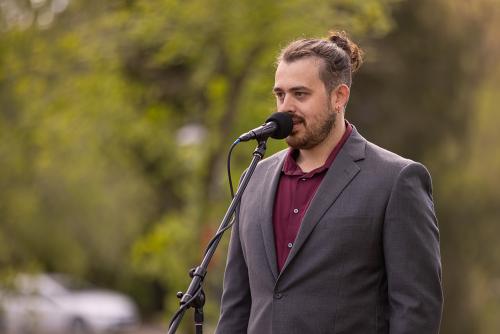UVA Wise Professor Wins Early Career Research Award

This Fourth of July, drivers will want to avoid holiday traffic, but they might be wary of billboards, too.
Across the United States, funeral home billboards reminding drivers not to text may be a case of the messenger truly being dangerous.
Research led by Robert Arrowood, University of Virginia’s College at Wise (UVA Wise) assistant professor of psychology, showed a nearly 400 percent increase in texting as an immediate reaction after drivers “saw a funeral home advertisement in a computer-simulated lab experiment” and in a real world observational study.
“Death Concerns and Distracted Driving: A Naturalistic and Experimental Study,” co-written by lead author, Arrowood, and Cathy R. Cox, Texas Christian University professor of psychology, garnered the coveted Southeastern Psychological Association (SEPA) Early Career Research Award in April. SEPA is the regional branch of the American Psychological Association. The study edged out 500 other entries.
“It’s a milestone every researcher fresh out of grad school wants. I was incredibly happy and humbled because there were so many great presentations,” said Arrowood, who presented his project at the SEPA conference in April, a professional forum for research conducted in psychology, and at the College’s spring research day.
The award honors scholars for research done within the first six years after graduate school.
“It's a really good project, and I'm glad that some news is getting out there about this project because it could potentially save some lives,” he said.
Arrowood is especially proud of the early career award because his project was up against scholars at much larger colleges and universities.
“I’m really excited that it’s connected to UVA Wise because of all the good research going on here,” Arrowood said. “Our small campus is often not considered for heavy research, but we won this national award. It feels pretty great.”
The study began while Arrowood was a Ph.D. candidate and research assistant at Texas Christian University. He joined the faculty of UVA Wise last year.
“I was driving, and looked up and saw this funeral home billboard that read, ‘If you text and drive, we have really cheap prices for caskets.’ It was basically trying to get people to stop texting while driving,” Arrowood said.
What caught his attention was the explicit death reminder embedded in the message: You could die if you text and drive.
“It had a picture of a body on a slab and a frown emoticon over the face,” he said. “If you are trying to persuade someone to do something, fear appeals are really effective. They work incredibly well.”
But Arrowood, creator of UVA Wise’s Existential Motives and Social Religiosity Lab, studies issues around fear and death and realized there might be an underlying problem with the billboards.
He said that when the threat of death becomes real for people, they do one of three things: defend their own worldviews and become really confident in their beliefs, boost their self-esteem by doing whatever they can to feel good about themselves, or cling to and try to protect close relations and loved ones.
“When I was driving in my car, I look up at this billboard and I see this death reminder for everyone to see. I'm thinking, we're going to do one of those three things,” he said.
The last one—cling to loved ones—could illicit a driver response that goes contrary to the billboard’s message.
“You're in a car by yourself and see the funeral home ad. You have a close relationship. Your instinct is going to be to text them or call them to reach out to them,” he said. “I thought this is going to be completely ineffective because people are going to have this defense mechanism against death and instead of lowering texting, it should increase it.”
Arrowood ran three experiments to test his theory.
In the first experiment, Arrowood and his research assistants went to the billboard intersection and observed hundreds of drivers’ reactions to seeing the billboard.
“We made sure that people looked up at the billboard and then we coded it for whether they texted or not. We compared that data to a control condition on the other side of the road where drivers couldn’t see the billboard,” he said.
The next two experiments, held in the research laboratory, included a driving simulator where “drivers” drove along a virtual course encountering the same billboards. Drivers also wore glasses that tracked their eye movement to monitor exactly where they were looking.
“Overall, we found that when people see this death billboard, whether naturally occurring or in an experiment, they start texting more,” Arrowood said.
In the simulated driving experience, texting increased by almost 400 percent, and also led to more swerving and crashes, he said.
“We were really trying to hone in on what kind of actionable change occurred and we needed a proof of concept because when you put a theory in the real world it can get a bit messier,” he said. “What we were really trying to say: does this reminder of death do the opposite of its goal?”
Arrowood said there are thousands of these advertisements displayed on billboards across the country.
“It’s concerning just how large of an effect it has. So, my goal now is to get these findings to businesses using these billboards so they can be aware of the risks of running this type of advertisement,” he said.
Approximately 25% of accidents in the United States are caused by texting while driving, prompting the creation of several media campaigns to reduce such risky behavior.
The final paper is currently under peer review at Death Studies, a scientific journal focusing on understanding how the awareness of death influences our behavior, thoughts, and feelings.